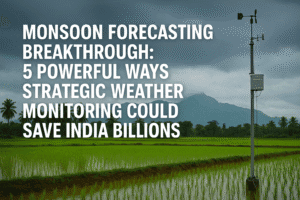Monsoon Forecasting Breakthrough: 5 Powerful Ways Strategic Weather Monitoring Could Save India Billions
Researchers from IIST Thiruvananthapuram and Vrije Universiteit Amsterdam have identified optimal locations for weather monitoring to improve India’s monsoon predictions. Using ensemble sensitivity analysis, they found that placing sensors in key regions—such as the Arabian Sea for the Western Ghats and localized stations in the Gangetic Basin—can significantly enhance forecast accuracy.
The study reveals that different variables (humidity, wind, pressure) require monitoring in distinct zones, demanding a tailored approach. Better data from these sensitive areas could help farmers, disaster agencies, and urban planners mitigate risks. However, shifting weather patterns mean adaptive strategies are essential. With millions relying on monsoon-dependent agriculture, refining forecasts isn’t just scientific progress—it’s a socioeconomic imperative for India’s future.

Monsoon Forecasting Breakthrough: 5 Powerful Ways Strategic Weather Monitoring Could Save India Billions
The Indian summer monsoon is a lifeline for millions, delivering nearly 70% of the country’s annual rainfall between June and September. Yet, its unpredictability can spell disaster—droughts devastate crops, while floods wreak havoc on cities and villages alike. Improving monsoon forecasts isn’t just a scientific challenge; it’s a socioeconomic necessity.
Recent research by scientists from the Indian Institute of Space Science and Technology (IIST), Thiruvananthapuram, and Vrije Universiteit, Amsterdam, has uncovered a promising strategy: optimizing the placement of weather-monitoring stations to enhance forecast accuracy. Their findings could revolutionize how India prepares for its most critical weather phenomenon.
Why Monsoon Forecasting Is So Difficult
Weather is inherently chaotic—tiny variations in initial conditions can lead to vastly different outcomes. Current forecasting models rely on global data, but not all regions contribute equally to prediction accuracy. The key lies in identifying **”sensitive zones”**—specific areas where better data collection can significantly refine forecasts.
Using ensemble sensitivity analysis, the researchers analyzed five years of monsoon data from the THORPEX Interactive Grand Global Ensemble (TIGGE) project, a global collaboration for weather prediction. Their goal? To determine where additional monitoring would have the greatest impact.
Key Findings: Where to Focus Monitoring Efforts
The study highlights distinct regions where enhanced data collection could drastically improve rainfall predictions:
- Western Ghats – Forecasts here are highly sensitive to upstream conditions over the Arabian Sea. Installing more buoys and weather stations in this area could provide earlier, more accurate warnings for heavy rainfall along the coast.
- Gangetic Basin – Unlike the Western Ghats, this region’s rainfall depends more on local atmospheric conditions. Ground-based weather stations here would yield better forecasts than remote sensing alone.
- Northeast India & Bay of Bengal – These areas show strong sensitivity to humidity and wind patterns. Monitoring these variables in real-time could improve predictions for extreme rainfall events.
Interestingly, the study also found that different weather variables (pressure, wind, humidity) require monitoring in different locations. This means a customized approach—rather than a blanket expansion of monitoring networks—could be far more effective.
The Real-World Impact: Why This Matters
Accurate monsoon forecasts have far-reaching consequences:
- Farmers can optimize planting and harvesting, reducing crop losses.
- Disaster management agencies can better prepare for floods or droughts.
- Urban planners can mitigate waterlogging and infrastructure damage in cities.
However, the study cautions that sensitive regions may shift year-to-year based on evolving weather patterns. Continuous research and adaptive monitoring strategies will be essential.
The Road Ahead
While this research provides a roadmap for optimizing India’s weather monitoring network, implementation will require collaboration between meteorologists, policymakers, and technology providers. Investments in automated weather stations, ocean buoys, and advanced satellite sensors in the identified zones could dramatically improve forecast reliability.
For a country where half the population depends on rain-fed agriculture, refining monsoon predictions isn’t just about better weather reports—it’s about securing livelihoods, saving lives, and building climate resilience.
Did You Know?
- The Himalayas play a crucial role in the monsoon by blocking dry winds and forcing moisture-laden air to rise, triggering rainfall.
- The THORPEX project (now part of the World Weather Research Programme) was a landmark effort in global weather forecasting collaboration.
- Small improvements in forecast accuracy can save billions in economic losses by enabling timely interventions.
By strategically placing monitoring equipment where it matters most, India could take a giant leap toward mastering monsoon prediction—turning uncertainty into actionable insight.
You must be logged in to post a comment.